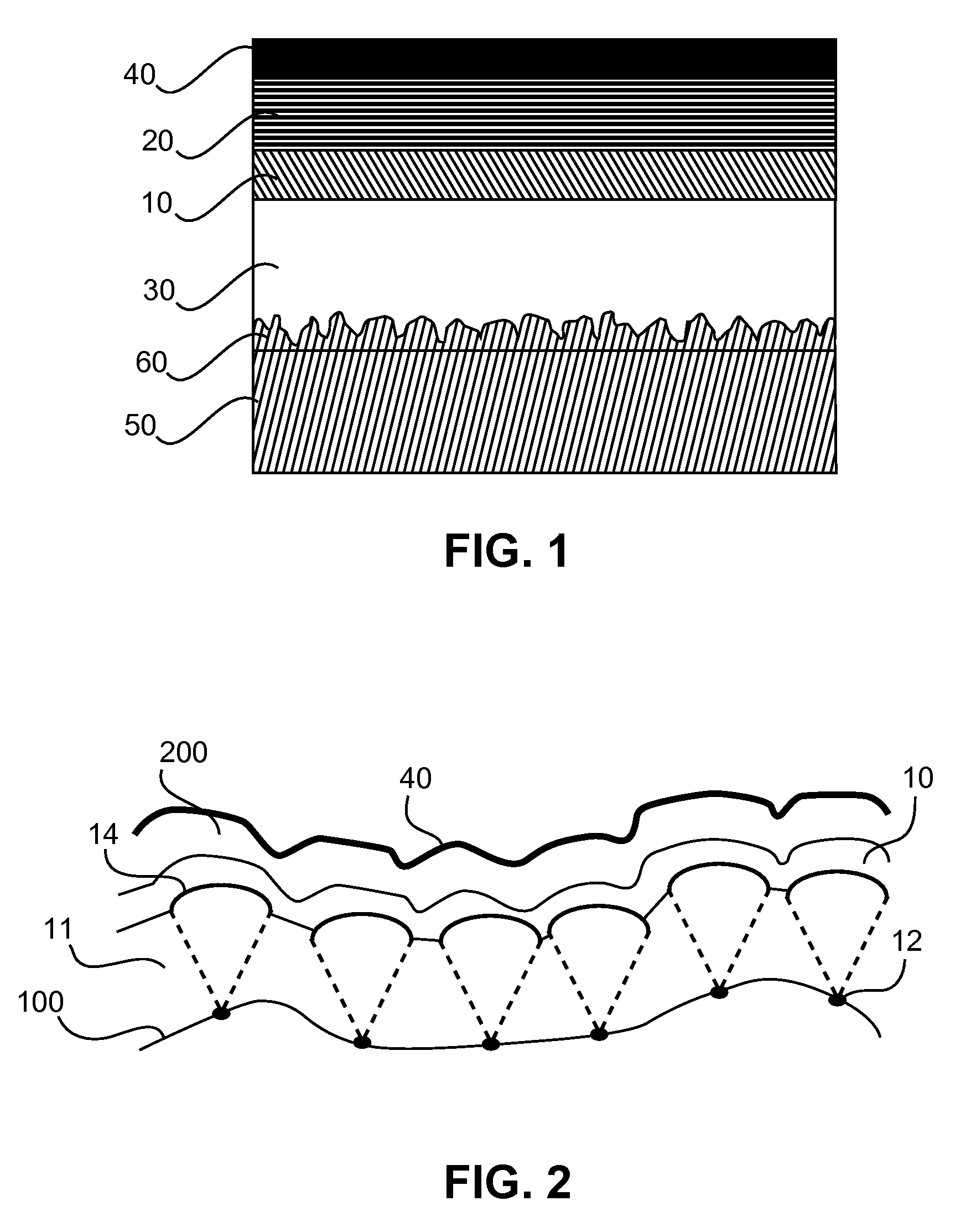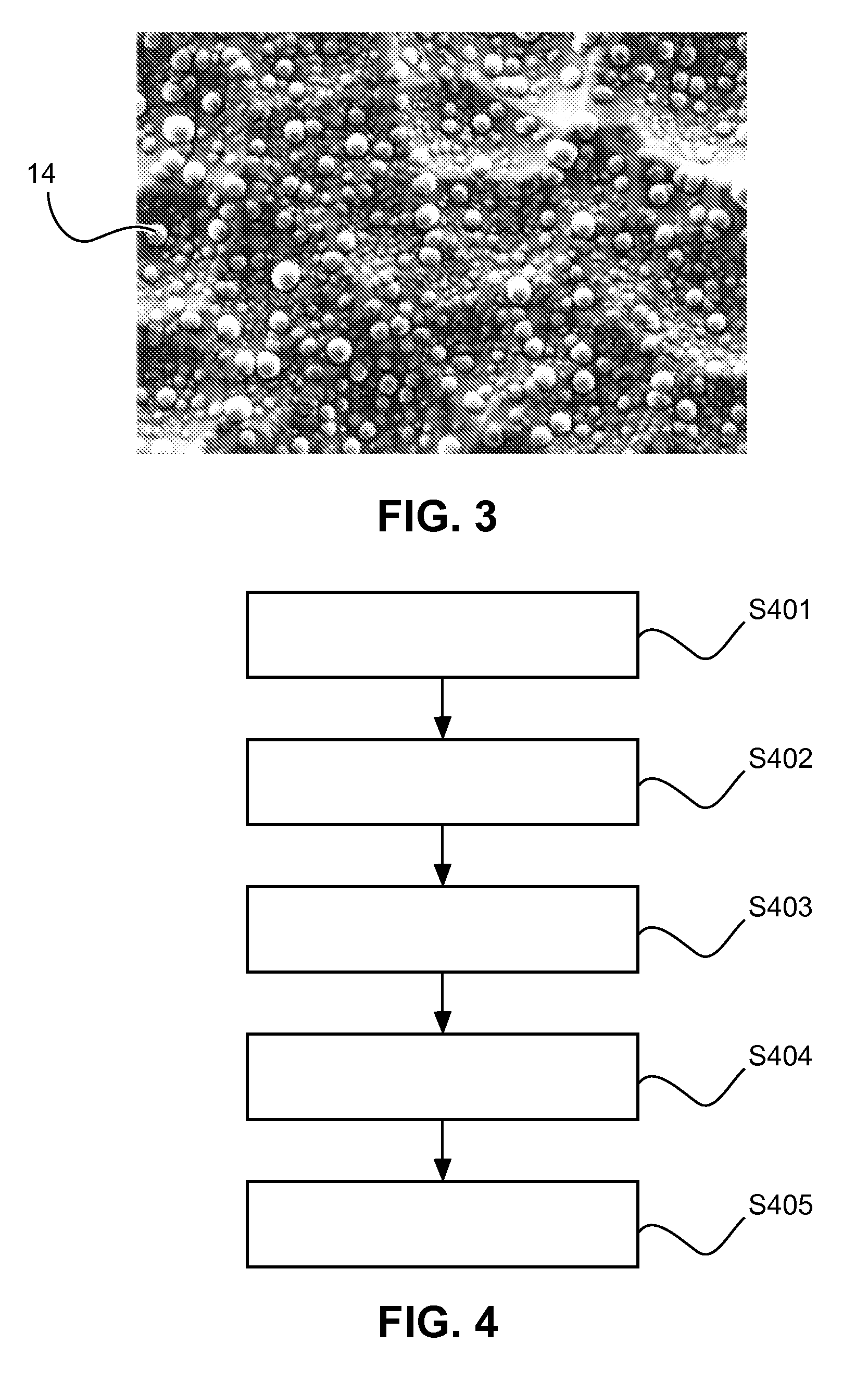Light emitting device with improved internal out-coupling and method of providing the same
a technology of light-emitting devices and internal out-coupling, which is applied in the direction of organic semiconductor devices, sustainable manufacturing/processing, final product manufacturing, etc., can solve the problem of additional roughening steps, and achieve the effect of improving the out-coupling structure and
- Summary
- Abstract
- Description
- Claims
- Application Information
AI Technical Summary
Benefits of technology
Problems solved by technology
Method used
Image
Examples
first embodiment
[0033]FIG. 2 shows a schematic cross sectional view of an OLED layer structure with improved columnar cone-shaped growth according to a The small ultrafine particles 12 or other surface defects on the surface 100 of the glass substrate induce locally different growth due to different sticking coefficients, with preferential columnar cone shaped growth, leading to bumps 14 of 0.5 to 4 μm, preferably 1 to 2 μm, cross-sectional dimension on the top surface of the CVD layer 11 underneath the lowest ITO layer (i.e. transparent electrode layer, e.g., anode layer 10) of the OLED layers 200 and the upper cathode layer 40. These bumps 14 are over-coated with the OLED layers 200 and induce sufficient scattering by subsequent reflections at several interfaces and at the cathode layer 40. The sticking coefficient is a term used in surface physics to describe the ratio of the number of adsorbate atoms (or molecules) that do adsorb, or “stick”, to a surface to the total number of atoms that impi...
second embodiment
[0036]In the following, a manufacturing process is described. An etching step is introduced as a pre-treatment of the glass substrate, which generates ultrafine particles deposited from the etching solution, which leads to local disturbancies of CVD layer growth. Thereby, relatively large lens like structures can be covered with much finer (mostly) bumps of only 0.5 to 4 μm, preferably 1 to 2 μm, extension. These bumps originated from growth disturbancies in the SiON CVD layer with high refractive index n. Hence, in consequence, it is no longer necessary to provide a rough surface base structure, but a flat glass substrates can be used with a suitable etching solution, eventually after etching a sacrificial glass plate, or by introducing ultrafine seed particles into the etching solution.
[0037]FIG. 4 shows a flow diagram of the manufacturing process according to the second embodiment. In step S401, the pre-treatment is done by exposure of the flat glass surface to a saturated etchi...
third embodiment
[0040]Thus, the pre-treatment of steps S401 and S402 of the above manufacturing process may be replaced by a step of providing local changes in the chemical surface composition of the glass substrate, e.g., by stronger oxidation (e.g. a material with an element with a higher or at least different oxidation state, thus modifying the initial growth inhibition by locally stronger growth).
PUM
 Login to View More
Login to View More Abstract
Description
Claims
Application Information
 Login to View More
Login to View More - R&D
- Intellectual Property
- Life Sciences
- Materials
- Tech Scout
- Unparalleled Data Quality
- Higher Quality Content
- 60% Fewer Hallucinations
Browse by: Latest US Patents, China's latest patents, Technical Efficacy Thesaurus, Application Domain, Technology Topic, Popular Technical Reports.
© 2025 PatSnap. All rights reserved.Legal|Privacy policy|Modern Slavery Act Transparency Statement|Sitemap|About US| Contact US: help@patsnap.com



